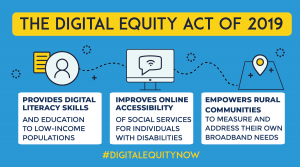Digital Equity
By Anusha Praturu | June 19, 2020
It’s no secret that in 2020, it is becoming increasingly difficult to participate in modern society without some level of access and literacy with basic technologies, the Internet being chief among them. And with the widespread growth of WiFi hotspots, smartphones, and other Internet-capable devices, it’s becoming easier for most of us to remain connected all the time. Despite this, the technology gap appears to be widening for lower-income American households.
According to a
2019 Pew Study detailed in the figure below, 44% of individuals with annual household incomes under $30,000 do not have home broadband services, and 46% do not have access to a traditional computer. These individuals are becoming progressively more dependent on smartphones for Internet access, even for tasks that are traditionally undertaken on a larger screen, such as applying to jobs or for educational purposes.
 Pew Research graphic depicting lower levels of technology adoption among lower income American households
Pew Research graphic depicting lower levels of technology adoption among lower income American households
Obviously these issues have many downstream implications, which contribute to perpetuating a cycle of inequality. These circumstances start to describe an issue known as digital inequity.
Defining Digital Equity and Digital Inclusion
Simply put, digital equity refers to people’s equal ability to access and use the necessary technology to participate in the social, democratic, and economic activities of modern society. The
National Digital Inclusion Alliance (NDIA) defines Digital Equity as follows:
Digital Equity is a condition in which all individuals and communities have the information technology capacity needed for full participation in our society, democracy and economy. Digital Equity is necessary for civic and cultural participation, employment, lifelong learning, and access to essential services.
A related concept, Digital Inclusion, refers to the acts of remediation that governments, activists, and other stakeholders are proposing and attempting in order to achieve digital equity. NDIA describes it as:
Digital Inclusion refers to the activities necessary to ensure that all individuals and communities, including the most disadvantaged, have access to and use of Information and Communication Technologies (ICTs). This includes 5 elements: 1) affordable, robust broadband internet service; 2) internet-enabled devices that meet the needs of the user; 3) access to digital literacy training; 4) quality technical support; and 5) applications and online content designed to enable and encourage self-sufficiency, participation and collaboration. Digital Inclusion must evolve as technology advances. Digital Inclusion requires intentional strategies and investments to reduce and eliminate historical, institutional and structural barriers to access and use technology.
Causes of Inequity
As you can imagine, the causes of digital inequity are deep-rooted and manyfold. Some of the primary causes, as detailed by the
Benton Institute include a lack of robust infrastructure and discrimination in delivering technology and digital services to specific areas or populations. Other barriers stem from broader issues such as disparities in socio-economic status, digital literacy, accommodations for special needs and disabilities, or resources for non-English speakers. These multifaceted sources of inequity cannot simply be addressed with a single piece of legislation or grant in funding. Rather, they require radical systemic change, including substantial and ongoing investment in lower-income and rural communities, as well as broader awareness of the growing issue.
Ongoing Attempts at Remediation
In April 2019, Senator Patty Murray of Washington introduced the
Digital Equity Act of 2019. This act would establish grants for the purposes of (1) promoting digital equity, (2) supporting digital inclusion activities, and (3) building capacity for state-led efforts to increase adoption of broadband by their residents. These efforts would contribute to achieving the goals outlined in the graphic below.
 Infographic detailing the three primary goals of the Digital Equity Act of 2019
Infographic detailing the three primary goals of the Digital Equity Act of 2019
Since being first introduced to the Senate in April and subsequently reintroduced to the House in September 2019 by Rep. Jerry McNerney of California, this act has yet to face a vote in either chamber.
In addition to legislation, there are several non-profit organizations that are committed to addressing the issue of digital inequity in the US. The leader of such organizations is the aforementioned National Digital Inclusion Alliance, which “combines grassroots community engagement with technical knowledge, research, and coalition building to advocate on behalf of people working in their communities for digital equity.” Organizations such as NDIA take a many-sided approach to digital inclusion, including spreading awareness, fundraising, research, advocacy, and lobbying policymakers.
Outstanding Barriers to Digital Equity
On top of those outlined above, there are still several barriers to achieving digital equity in the US. Simply the fact that legislation on the issue was introduced over a year ago and has not made any progress through the legislative branch of government is a clear indication that more public advocacy and awareness is needed for such action to have momentum. Another issue that must be addressed by digital inclusion efforts is the rapid pace of new developments in technology. Inclusion efforts must be up to date and compatible with the evolving technological landscape. Digital equity cannot be achieved if lower-income and otherwise disadvantaged populations are restricted to outdated technology or insufficient access to the latest developments.
The bottom line is, the road to digital equity is long and not without obstacles, but efforts to close the gap are long overdue. Further, the gap will only continue to widen with each year that goes by and technology advances, yet no action is taken to promote digital inclusion. The first of many steps will be to lobby policymakers to push the Digital Equity Act through to a vote so that the issue of inequity might finally start to be addressed and penetrate the American consciousness in a meaningful way.
 Pew Research graphic depicting lower levels of technology adoption among lower income American households
Obviously these issues have many downstream implications, which contribute to perpetuating a cycle of inequality. These circumstances start to describe an issue known as digital inequity.
Defining Digital Equity and Digital Inclusion
Simply put, digital equity refers to people’s equal ability to access and use the necessary technology to participate in the social, democratic, and economic activities of modern society. The National Digital Inclusion Alliance (NDIA) defines Digital Equity as follows:
Pew Research graphic depicting lower levels of technology adoption among lower income American households
Obviously these issues have many downstream implications, which contribute to perpetuating a cycle of inequality. These circumstances start to describe an issue known as digital inequity.
Defining Digital Equity and Digital Inclusion
Simply put, digital equity refers to people’s equal ability to access and use the necessary technology to participate in the social, democratic, and economic activities of modern society. The National Digital Inclusion Alliance (NDIA) defines Digital Equity as follows:
 Infographic detailing the three primary goals of the Digital Equity Act of 2019
Since being first introduced to the Senate in April and subsequently reintroduced to the House in September 2019 by Rep. Jerry McNerney of California, this act has yet to face a vote in either chamber.
In addition to legislation, there are several non-profit organizations that are committed to addressing the issue of digital inequity in the US. The leader of such organizations is the aforementioned National Digital Inclusion Alliance, which “combines grassroots community engagement with technical knowledge, research, and coalition building to advocate on behalf of people working in their communities for digital equity.” Organizations such as NDIA take a many-sided approach to digital inclusion, including spreading awareness, fundraising, research, advocacy, and lobbying policymakers.
Outstanding Barriers to Digital Equity
On top of those outlined above, there are still several barriers to achieving digital equity in the US. Simply the fact that legislation on the issue was introduced over a year ago and has not made any progress through the legislative branch of government is a clear indication that more public advocacy and awareness is needed for such action to have momentum. Another issue that must be addressed by digital inclusion efforts is the rapid pace of new developments in technology. Inclusion efforts must be up to date and compatible with the evolving technological landscape. Digital equity cannot be achieved if lower-income and otherwise disadvantaged populations are restricted to outdated technology or insufficient access to the latest developments.
The bottom line is, the road to digital equity is long and not without obstacles, but efforts to close the gap are long overdue. Further, the gap will only continue to widen with each year that goes by and technology advances, yet no action is taken to promote digital inclusion. The first of many steps will be to lobby policymakers to push the Digital Equity Act through to a vote so that the issue of inequity might finally start to be addressed and penetrate the American consciousness in a meaningful way.
Infographic detailing the three primary goals of the Digital Equity Act of 2019
Since being first introduced to the Senate in April and subsequently reintroduced to the House in September 2019 by Rep. Jerry McNerney of California, this act has yet to face a vote in either chamber.
In addition to legislation, there are several non-profit organizations that are committed to addressing the issue of digital inequity in the US. The leader of such organizations is the aforementioned National Digital Inclusion Alliance, which “combines grassroots community engagement with technical knowledge, research, and coalition building to advocate on behalf of people working in their communities for digital equity.” Organizations such as NDIA take a many-sided approach to digital inclusion, including spreading awareness, fundraising, research, advocacy, and lobbying policymakers.
Outstanding Barriers to Digital Equity
On top of those outlined above, there are still several barriers to achieving digital equity in the US. Simply the fact that legislation on the issue was introduced over a year ago and has not made any progress through the legislative branch of government is a clear indication that more public advocacy and awareness is needed for such action to have momentum. Another issue that must be addressed by digital inclusion efforts is the rapid pace of new developments in technology. Inclusion efforts must be up to date and compatible with the evolving technological landscape. Digital equity cannot be achieved if lower-income and otherwise disadvantaged populations are restricted to outdated technology or insufficient access to the latest developments.
The bottom line is, the road to digital equity is long and not without obstacles, but efforts to close the gap are long overdue. Further, the gap will only continue to widen with each year that goes by and technology advances, yet no action is taken to promote digital inclusion. The first of many steps will be to lobby policymakers to push the Digital Equity Act through to a vote so that the issue of inequity might finally start to be addressed and penetrate the American consciousness in a meaningful way. 